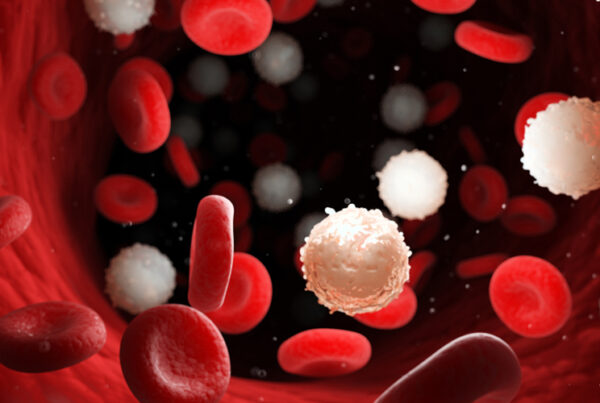
Myelofibrosis (MF) is a rare type of blood cancer. It happens when scar tissue builds up inside your bone marrow—the soft, spongy part of your bones that makes blood cells. This scarring makes it harder for your body to produce healthy blood cells.
Normally, your bone marrow makes stem cells that turn into:
- Red blood cells – carry oxygen
- White blood cells – fight infections
- Platelets – help with blood clotting
In myelofibrosis, a change in the genes of these stem cells turns them into cancer cells. These cells grow too fast and cause inflammation, which leads to scarring in the bone marrow. As a result, the bone marrow can’t make enough healthy blood cells.
Over time, the spleen (an organ that filters abnormal blood cells) tries to help, but it can become enlarged and lead to symptoms like pain or discomfort.
Types of Myelofibrosis
There are two main types:
Primary Myelofibrosis
- This type happens on its own, without any previous blood disorder.
- It is also called Idiopathic Myelofibrosis, meaning its cause is unknown.
- It is the most common form of MF.
Secondary Myelofibrosis (also called Post-ET or Post-PV MF)
a) This type develops from other blood conditions like:
i) Essential thrombocythemia (ET) – too many platelets
ii) Polycythemia Vera (PV) – too many red blood cells
b) These belong to a group of blood cancers called myeloproliferative neoplasms (MPNs),
in which your bone marrow produces too many blood cells.
Symptoms of Myelofibrosis
- People with myelofibrosis may have:
- Tiredness or weakness
- Shortness of breath, even with light activity
- Pain or a heavy feeling under the left ribs (from an enlarged spleen)
- Bruising easily, even from small bumps
- Bleeding more easily than usual
- Night sweats (waking up soaked in sweat)
- Fever without a clear reason
- Pain in the bones
- Feeling full quickly, even after eating just a small meal
What Causes Myelofibrosis?
Doctors don’t always know the exact cause of myelofibrosis. But here’s what they do know:
It Starts in the Bone Marrow
Your bone marrow is the soft tissue inside your bones. It makes blood stem cells, which can become three types of blood cells:
- Red blood cells
- White blood cells
- Platelets
DNA Changes in Stem Cells
In myelofibrosis, something goes wrong in the DNA, which disrupts the function of stem cells and causes them to:
- Make too many blood cells
- Produce cells that don’t work properly
These faulty instructions also cause scarring in the bone marrow. This scarring makes it harder to produce healthy blood cells.
What Happens Next?
Because of these changes:
- You have too many abnormal blood cells
- Your bone marrow can’t make enough healthy blood cells
This leads to common symptoms like tiredness, weakness, and shortness of breath—especially when you don’t have enough red blood cells to carry oxygen.
Possible Genetic Causes
Doctors have found that changes in certain genes may be linked to myelofibrosis. These include:
- JAK2 (Janus kinase 2)
- CALR (Calreticulin)
- MPL (Thrombopoietin receptor)
Your healthcare provider may test for these gene changes to help guide your treatment plan and understand how the disease may progress.
How Serious Is Myelofibrosis?
It’s a long-term (chronic) condition. In many cases, it develops slowly. However, in some people, it can progress quickly or even turn into a more aggressive cancer called acute leukemia. That’s why doctors carefully monitor your health after diagnosis.
Is Myelofibrosis Cancer?
Is Myelofibrosis Cancer? This question often arises because myelofibrosis is a serious bone marrow disorder that affects blood cell production. While it is not classified as a solid tumor, it is considered a type of blood cancer due to its impact on bone marrow function. Understanding whether myelofibrosis is cancer helps patients recognize symptoms early and seek timely medical care.
How Is Myelofibrosis Diagnosed?
Diagnosing myelofibrosis usually starts with a physical exam and is followed by blood tests, imaging scans, and bone marrow tests.
1. Physical Exam
Your doctor will:
- Ask about your symptoms
- Feel your abdomen to check if your spleen or liver is enlarged
2. Blood Tests
A common test is a complete blood count (CBC), which checks the levels of:
- Red blood cells – often low in myelofibrosis
- White blood cells and platelets – may be higher or lower than normal
3. Imaging Tests
Scans like CT or MRI create pictures of the inside of your body. These help the doctor:
- Check if your spleen or liver is enlarged
- Look for signs of scarring in the bone marrow
4. Bone Marrow Tests
To confirm the diagnosis, doctors collect samples from your hip bone using a needle. This includes:
- Bone marrow aspiration – collects liquid from the marrow
- Bone marrow biopsy – takes a small piece of solid tissue
These tests look for scarring in the bone marrow—a key sign of myelofibrosis.
5. Genetic Testing
If abnormal cells are found, they may be tested for DNA changes. These genetic mutations help confirm the diagnosis and guide treatment. The most common changes are in:
- JAK2
- CALR
- MPL
Read More: What is Bone Marrow Edema: Signs, Treatments, and What to Expect
Treatment for Myelofibrosis
Treatment depends on how severe your symptoms are and how the disease is progressing. Some people may not need treatment right away and are just monitored regularly.
1. Watchful Waiting
If symptoms are mild or not present, your doctor may simply monitor your health with regular checkups and tests.
2. Medications
These help manage symptoms and improve blood cell counts:
- JAK Inhibitors (like ruxolitinib or fedratinib):
Help reduce spleen size and ease symptoms like fatigue and night sweats. - Medications to Boost Blood Counts:
- Erythropoietin-stimulating agents for anemia
- Androgens (male hormones) to help the bone marrow produce more red blood cells
3. Blood Transfusions
Used for severe anemia to increase red blood cell levels and relieve fatigue.
4. Splenectomy or Radiation
- Surgery to remove the spleen (splenectomy) if it’s too large or causing pain
- Radiation therapy may shrink the spleen if surgery isn’t possible
5. Stem Cell Transplant (Bone Marrow Transplant)
- The only potential cure for myelofibrosis
- Replaces the damaged bone marrow with healthy stem cells from a donor
- Best suited for younger, healthier patients, as it has serious risks
6. Clinical Trials
You may also be able to join Myelofibrosis Clinical Trials in Nebraska, where new and potentially more effective treatments are being tested.
What is the Difference Between Leukemia and Myelofibrosis?
The difference between leukemia and myelofibrosis lies in how each affects blood cell production. Leukemia causes the rapid growth of abnormal white blood cells, while myelofibrosis leads to scarring in the bone marrow, reducing healthy blood cell production.
What Is the Difference Between Myelofibrosis and Myelodysplastic Syndrome?
The difference between myelofibrosis and myelodysplastic syndrome lies in how each affects blood cell development. Myelofibrosis leads to bone marrow scarring and abnormal blood production, while myelodysplastic syndrome (MDS) causes the bone marrow to produce misshapen or immature blood cells, often leading to anemia or low blood counts.
How Clinical Trials Are Shaping the Future of Oncology
Clinical research studies play a crucial role in advancing cancer treatment. By participating in these studies, patients not only receive access to potential new therapies but also contribute to medical discoveries that could benefit countless others in the future.
Clinical trials for oncology are essential for testing new cancer treatments and improving existing ones. They help researchers understand how therapies work in real patients, leading to better, more targeted care and improved survival rates.
FAQS
Is myelofibrosis cancer?
Yes, myelofibrosis is a rare type of blood cancer that affects the bone marrow and leads to abnormal blood cell production.
Is myelofibrosis hereditary?
Most cases of myelofibrosis are not inherited. It usually develops due to genetic changes in blood cells acquired during a person’s life.
How aggressive is myelofibrosis?
Myelofibrosis can vary in aggressiveness. It often progresses slowly, but in some cases, it can become severe or turn into acute leukemia.
What are the first symptoms of myelofibrosis?
Early symptoms may include fatigue, weakness, shortness of breath, and pain or fullness below the ribs on the left side due to an enlarged spleen.







